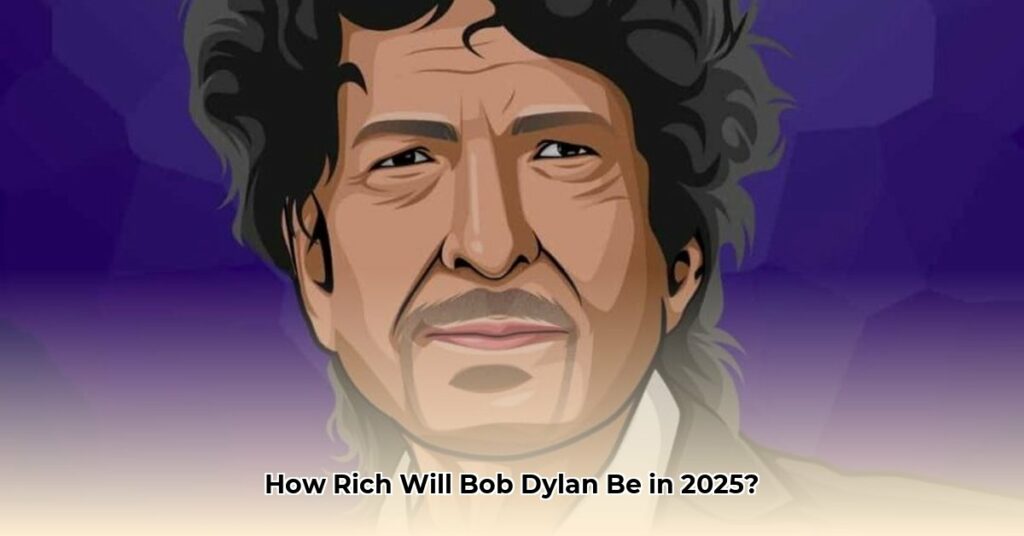Bob Dylan’s net worth is estimated at a staggering $500 million in 2025. This article explores how the enigmatic musician amassed his wealth, from his groundbreaking music to savvy business moves.
Decoding Dylan’s Millions
Bob Dylan, the voice of a generation, is also a financial heavyweight. His $500 million fortune isn’t just from record sales—it’s a complex tapestry woven from decades of strategic decisions and a keen understanding of the music business.
The Pillars of Dylan’s Fortune
Dylan’s wealth isn’t simply the result of hit records; it’s a combination of several key income streams. Here’s a breakdown:
-
The Catalog Sale(s): A Game Changer: In a move that reverberated throughout the industry, Dylan sold his songwriting catalog to Universal Music Publishing Group for a reported $300-$400 million in 2020. This sale encompassed the rights to over 600 songs, giving Universal control over licensing for film, television, and other uses. Separately, he sold his master recordings—the original studio recordings of his songs—to Sony Music Entertainment for an estimated $200 million in 2021 (announced in January 2022).
-
The Never-Ending Tour: A Financial Juggernaut: Since 1988, the “Never-Ending Tour” has not only cemented Dylan’s connection with fans but also generated significant revenue. While precise figures are elusive, estimates suggest that Dylan’s income from touring likely contributes tens of millions to his coffers annually. With varying ticket prices and venue sizes, the income generated per show has probably fluctuated over the years. Some suggest earnings began around $100,000 per show in the early days, potentially soaring into the hundreds of thousands or even nearing a million per show in more recent years. With such a prolific touring schedule, it’s safe to say that he’s grossed tens, if not hundreds, of millions of dollars over the tour’s duration.
-
Royalties: The Gift That Keeps on Giving: Even without the catalog sale, Dylan’s music continues to generate substantial royalty income. His vast catalog, spanning decades, earns him money every time a song is played on the radio, streamed, or used in a film or commercial. This likely adds millions of dollars to his net worth each year.
-
Beyond Music: Diversifying the Empire: Dylan’s creative pursuits extend beyond songwriting. His ventures into visual art, literature (including his memoir, Chronicles: Volume One), and even the co-founding of Heaven’s Door whiskey, all likely contribute to his overall wealth, although the exact figures are difficult to ascertain. His previous real estate holdings, including properties in Malibu and formerly Manhattan and Scotland, also suggest a diversified investment portfolio.
| Income Source | Estimated Value (USD) |
|---|---|
| Song Catalog Sale | $300-$400 Million |
| Master Recordings Sale | $200 Million |
| “Never-Ending Tour” | Undisclosed (tens of millions annually) |
| Royalties | Undisclosed (millions annually) |
| Heaven’s Door Whiskey | Undisclosed |
| Art & Other Ventures | Undisclosed |
The Dylan Business Model: Artistry and Acumen
Dylan’s financial success isn’t just about luck; it reveals a sharp business mind. His decision to sell his catalog while the market was booming suggests a keen awareness of market trends and financial planning. By securing a substantial lump sum, he simplified his estate and capitalized on the high demand for music rights in the digital age.
Early Influences and the Birth of an Icon
Dylan’s journey began in Hibbing, Minnesota, where the sounds of mining operations mingled with his burgeoning passion for blues and folk music. Inspired by artists like Woody Guthrie, he ventured to New York City’s Greenwich Village in 1960, immersing himself in the folk scene and forging his unique musical identity. His early albums, including The Freewheelin’ Bob Dylan and Highway 61 Revisited, propelled him to international fame, shaping the cultural landscape of the 1960s. This early success laid the foundation for the financial empire he would later build.
The Legacy Continues
Bob Dylan’s net worth is a testament to his enduring influence, both artistically and financially. While the precise figure remains somewhat elusive, the available information suggests a fortune of around $500 million—a testament to his creative genius and shrewd business decisions. As his music continues to resonate with generations, his financial legacy, much like his music, remains a complex and evolving narrative. The impact of his catalog sale on the music industry continues to be debated, raising questions about artistic ownership and the long-term value of creative work in the digital era. Ongoing research and evolving interpretations of Dylan’s work ensure that his legacy, in both art and finance, remains a subject of fascination and discussion.



